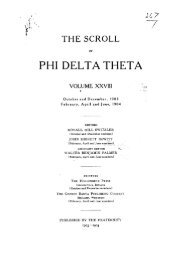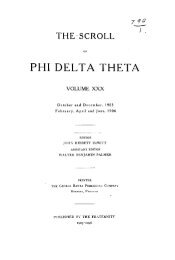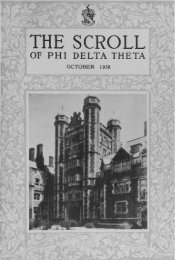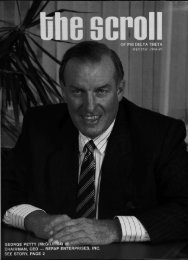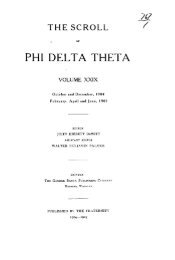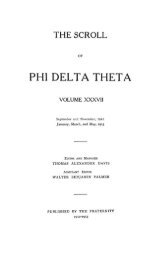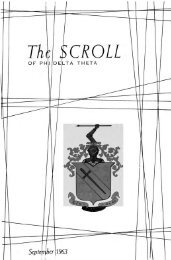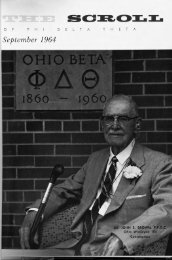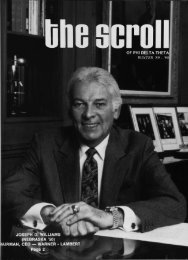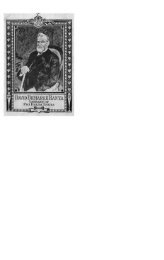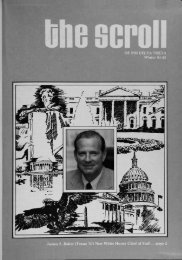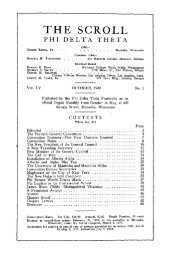1953–54 Volume 78 No 1–5 - Phi Delta Theta Scroll Archive
1953–54 Volume 78 No 1–5 - Phi Delta Theta Scroll Archive
1953–54 Volume 78 No 1–5 - Phi Delta Theta Scroll Archive
Create successful ePaper yourself
Turn your PDF publications into a flip-book with our unique Google optimized e-Paper software.
A Corner With <strong>Phi</strong> Authors<br />
Love That Golf by DON HEROLD, Indiana<br />
'12. A. S. Barnes.<br />
Brother Herold, who didn't take up the game<br />
of golf until he was 45, has written a book that<br />
will help the average amateur hacker more, we<br />
believe, than most scientific treatises by the pros.<br />
His thesis throughout the book is "take it<br />
easy," "be relaxed," and "enjoy the game<br />
more." It is packed with tips concerning those<br />
particular shots that will take strokes off your<br />
score—tips that even the weekend golfer can put<br />
into practice at once. He approaches the game<br />
from the viewpoint that most strokes are wasted<br />
up around the green (and how right he is).<br />
Mr. Herold, therefore, goes about it bassackwards<br />
to the usual book on golf—and starts with<br />
the putter, working down through the irons<br />
and woods to the driver.<br />
Although most of the tips and advice in the<br />
book are Brother Herold's, its pages are also<br />
sprinkled with observations by the game's great,<br />
most of them close friends of the author. As<br />
would be expected too, of course, the book contains<br />
many of the inimitable Herold cartoons,<br />
each of which graphically depicts a point of<br />
form—good or bad.<br />
We might turn this into a testimonial and<br />
tell how many strokes we've cut off our score<br />
after reading the book, but this would call for<br />
certain specifics and—after all—golf has a rather<br />
short season in Wisconsin! We will urge every<br />
<strong>Phi</strong> golfer who'd like some good advice on his<br />
game to buy and read a copy of Love That Golf.<br />
It's written in the informally humorous Herold<br />
style and you'll enjoy reading it too!<br />
How To Believe by DR. RALPH W. SOCKMAN,<br />
Ohio Wesleyan '11. Doubleday.<br />
In this book, Dr. Sockman speaks clearly and<br />
simply about the questions which trouble man's<br />
religious faith. Sometimes they are almost naive,<br />
such as the one, "If God is everywhere, why do<br />
we need altars and special places of worship"<br />
Sometimes they are very important and perplexing,<br />
such as the one, "Do we really have<br />
any reliable evidence for the resurrection of<br />
Jesus" <strong>No</strong> doubt every person could list a number<br />
of these questions which have come to his<br />
own mind. He is grateful, therefore, to see them<br />
listed and answered in this book.<br />
Dr. Sockman is in a good position to write<br />
this book. For 35 years he has been the pastor of<br />
Christ church, ii^ the very heart of Manhattan.<br />
For 25 years he has had a national radio pulpit<br />
broadcast. Some 2 million letters have come to<br />
him from his listeners. He knows what questions<br />
disturb the modem mind. That is why we are<br />
inclined to feel that in his discussions he<br />
answers our questions, even before we actually<br />
fbrmulate them.<br />
The chapters of this book mark the great<br />
affirmations of the Apostle's Creed. This is a<br />
convenient device for purpose of discussion,<br />
since the creed encompasses most of the questions<br />
about religion that we are likely to ask.<br />
Each chapter is divided into the major questions<br />
concerning a particular article of faith. In the<br />
consideration of eternal life, for example, we<br />
find such topics as these: Is death a disagreeable<br />
subject What do we mean by resurrection of<br />
the body What do we mean by life everlasting<br />
Is the universe honest What will the future<br />
life be like<br />
These major questions are followed by secondary<br />
ones, thus bringing to the reader a comprehensive<br />
understanding of religious faith<br />
from one of the most active and well known<br />
churchmen in Protestant Cliristianity today.—<br />
Chicago Tribune Magazine of Books.<br />
* « •<br />
Corpus of Joe Bailey by OAKLEY MAXWELL<br />
HALL, JR., California '44. Viking Press.<br />
The locale of much of this book, which hit<br />
the best seller lists across the nation last Spring<br />
is the *Ae house at the University of California,<br />
where the author. Brother Hall, lived<br />
during his undergraduate days. Through the<br />
story the Fraternity is referred to as Omega<br />
Alpha.<br />
In his review of the book in the New York<br />
Times, Charles Poore states, in part:<br />
"Half a dozen novels are in this book. Although<br />
they are strung together to make a single<br />
narrative, a patient, scholarly editor might<br />
thriftily carve them out as separate entities.<br />
There is the novel of Joe Bailey's childhood,<br />
summed up in a recurring loss of social stature<br />
born of the depression years. There is the story<br />
of his schooldays. This is followed by a period<br />
that amounts to a full-length college novel, and<br />
is, I think, the most effective part of the book<br />
—the core of it certainly. There is the story of<br />
his war experiences, . . . and finally, there is<br />
the story of his harassed attempts to find a place<br />
for himself in civilian life—the novel of postwar<br />
adjustment. . . ."<br />
Brother Hall, 33 years old, was graduated<br />
from the University of California and studied<br />
at Oxford and the Sorbonne.<br />
bt]



